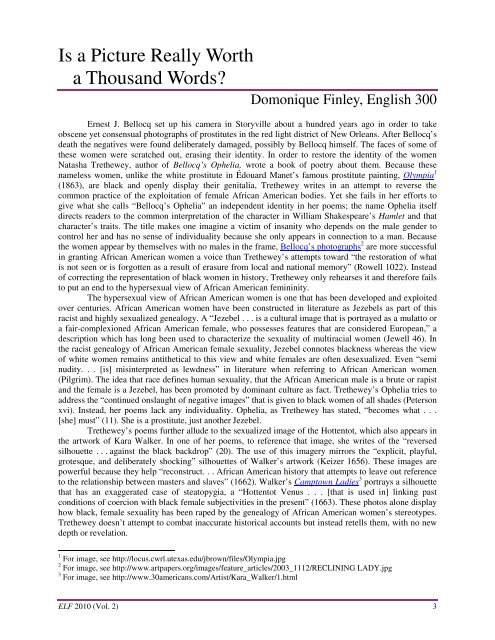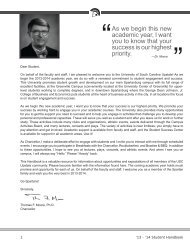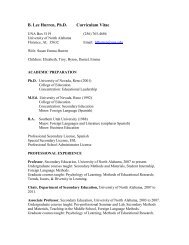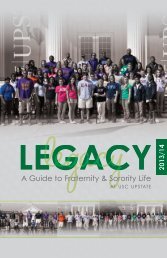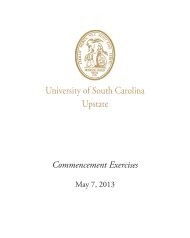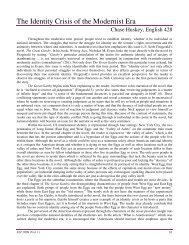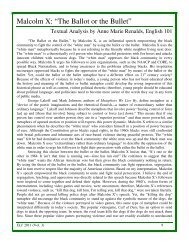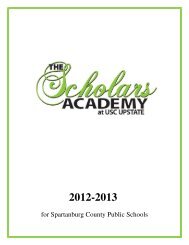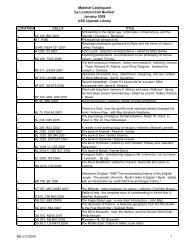Is a Picture Really Worth a Thousand Words? - University of South ...
Is a Picture Really Worth a Thousand Words? - University of South ...
Is a Picture Really Worth a Thousand Words? - University of South ...
You also want an ePaper? Increase the reach of your titles
YUMPU automatically turns print PDFs into web optimized ePapers that Google loves.
Misguided stereotypes about the hypersexuality <strong>of</strong> African American women are more fullycorrected in the work <strong>of</strong> Toni Morrison and Sojourner Truth than in the poems <strong>of</strong> Trethewey. In contrastto the poet, Morrison uses her novel Beloved to “rewrite the history <strong>of</strong> African American women . . . byaffirming the ineffable beauty <strong>of</strong> these bodies” (Peterson 16). She knows that words can never paint thetruth because it has been so badly damaged throughout history, yet feels obligated to <strong>of</strong>fer a lessstereotypical view <strong>of</strong> black femininity. Instead <strong>of</strong> recognizing that African American women may have“self-respect, self-control, and modesty—even sexual purity [like] white women” (Jewell 24), Tretheweymerely resurrects the past without the complexity found in Morrison’s books. She neglects the history <strong>of</strong>African American women, whereas other writers like Morrison and Truth work to correct the past. WhenTruth draws attention to her body in her speeches she reverses the sexual view <strong>of</strong> women <strong>of</strong> her race byportraying the “bodily labor” she participated in as a slave, and her “child bearing,” in order to“transform . . . her female sexuality into tools <strong>of</strong> labor . . . as a black woman worker” (Peterson 14). Shetakes a different approach than other speakers and writers by reshaping the view <strong>of</strong> African Americanwomen through her own struggle. Because the “nineteenth century stereotype stay[s] problematicallylodged in the popular memory [<strong>of</strong> Americans] today,” modern African American writers should work tocombat all negative stereotypes <strong>of</strong> black sexuality (Brady 264). Trethewey, unlike Morrison or Truth,fails to reverse or critique misconceptions and even keeps them alive in the twenty first century.Arlene Keizer poses the question, “Can this past ever be put to rest?” Because the past shapes thefuture, it will always be part <strong>of</strong> the present. In regard to Keizer’s idea <strong>of</strong> post memory as the “hauntedcondition, in which images from the past hover over the present or erupt into it,” Trethewey only aids inthe systematic psychic dismembering <strong>of</strong> the cross-racial body (1650). Trethewey’s failure to tackle thepast could have been prevented had she given Ophelia more depth and complexity as a woman than thecommon stereotypes <strong>of</strong> the character do. The women in Bellocq’s photographs appear to be <strong>of</strong> Europeandescent, depth is only granted to these women when their black identity and background is examined.Trethewey introduces the world to the Storyville prostitutes and gives them a race in her poetry. Thisrevelation <strong>of</strong> race adds implied meaning to the photographs that could have been disregarded otherwisesuch as the idea <strong>of</strong> the tragic mulatto, Jezebel or the sexually seductive stereotype which surroundsAfrican American females. As Annette Debo notes, Trethewey “gives voice to the African American sexworkers living in Storyville” (201), but this voice only reiterates the negative depictions and deleteriousevents suffered by African Americans <strong>of</strong> the time.This use <strong>of</strong> race and sexuality is commonly found in literature. Race in Trethewey’s case is now a“placeholder for a less stark, more complex set <strong>of</strong> relations <strong>of</strong> domination for which we do not yet have aliterary or visual language” for sexuality (Keizer 1650). Trethewey constructs Ophelia through heracquisition <strong>of</strong> a drop <strong>of</strong> black blood, which can be dated back to slavery through the relationships mastershad with female slaves through the “context <strong>of</strong> coercion” (Peterson 15). White males felt they had theright to access the bodies <strong>of</strong> African American females through sex, which gave birth to many Ophelias,young black women who seek fulfillment through men. Many young women whose mothers weresubjected to rape would never know the identity <strong>of</strong> their fathers, like Trethewey’s Ophelia, so they seekout other methods <strong>of</strong> affection from men. Because <strong>of</strong> this, slavery itself has an impact on the laterprostitution <strong>of</strong> female black bodies.Ophelia, whose existence is based upon the system <strong>of</strong> placage, is never transformed by hercondition in Trethewey’s poems. Joseph Roach describes “the weird demimonde <strong>of</strong> placage, [as] theCreole custom <strong>of</strong> arranging extramarital liaisons with educated mulattos” in New Orleans (217). Thiscustom is related in the lines “earliest training—childhood—how/ [her] mother taught [her] to curtsy andbe still /so that [she] might please a white man, [her] father” (Trethewey 20). Unable to grasp the idea <strong>of</strong>independence as a woman, Ophelia remains a victim <strong>of</strong> placage. The subjects <strong>of</strong> Bellocq’s photographscould be misread as white women, but Trethewey reveals the racial background and casts Ophelia into thepermanent role <strong>of</strong> a victim. She treads on the thin line between the depiction <strong>of</strong> black prostitutes asindividual victims <strong>of</strong> circumstance and women plagued by historical curses. She rehearses many eventsthat undermine the African American female gender but fails to transform any views.Trethewey’s Ophelia, like Shakespeare’s character, is dependent on men for survival. In “TheNaming” she describes meeting her father: “my mother pushed me toward a white man . . . Your father, /ELF 2010 (Vol. 2) 4
she whispered. He’s the one that named you, girl” (37). From this moment onward she suffers from aneed for attachment to the male gender; her father created her and, because <strong>of</strong> his position and race, she isnow a victim <strong>of</strong> the genealogy associated with mulattos. She transcribes this idea onto Bellocq whenOphelia claims that “this photograph we make / will bear the stamp <strong>of</strong> his name, not mine” (39), eventhough she is the subject and without her there would be no artwork.The elements that Trethewey incorporates from the African American women’s genealogy in herpoetry include the idea <strong>of</strong> the tragic mulatto, African American subservience, and the rehearsal <strong>of</strong> slavery.The events that helped in the creation <strong>of</strong> this racist genealogy are also present in the fancy girl auctionsand the exploitation <strong>of</strong> Saartji Baartman. In the poem “December 1910,” Trethewey juxtaposes the tragicmulatto with a fancy girl auction; Ophelia describes how “the auction was near” and her “dignifiedbirth . . . [was] a tragic occasion” (13). She is surrounded by “wealthy gentlemen” and she must “recitepoetry” for these men: she claims that she is “the African Violet for the promise / <strong>of</strong> that wild continenthidden beneath / [her] white skin,” which calls attention to her “wild” side because <strong>of</strong> the African heritageshe inherits from her mother (13). The fancy girl auction is further developed to the point where she goes“upstairs with the highest bidder” (14); her prostitution marks an end to the poem. History has shown howfancy girl auctions are damaging to a woman’s sense <strong>of</strong> self worth, but Trethewey only retells what wealready know rather than giving Ophelia an identity or an escape route.Another example <strong>of</strong> this particular genealogy can be found in the case <strong>of</strong> Saartji Baartman, a<strong>South</strong> African woman from two centuries ago who was famous for her case <strong>of</strong> steatopygia, an extremeaccumulation <strong>of</strong> body fat around the buttocks. Because <strong>of</strong> her enormous buttocks she was seen as animallike,a “freak show” to be stared at (Brady 263). After she agreed to be taken from Africa to England,Baartman was put on display where customers (including males and females) were able to touch herabnormal body parts. Eventually this display grew into the “crude stereotype <strong>of</strong> black femininity,”Baartman’s exploitation became the accepted stereotype for women <strong>of</strong> African descent including AfricanAmerican females (Brady 263). Although Baartman was <strong>of</strong> pure African descent her sexuality soonbecame a trait that Europeans likened to all shades <strong>of</strong> the African Diaspora, an indication that “whiteculture defines blackness and vice versa” (Fanon 104). Trethewey alludes to this representation <strong>of</strong>Ophelia’s physical attributes when she notes “a glass or a pair <strong>of</strong> boots propped upon my back,” areference to the women in Bellocq’s photographs with oversized buttocks (14). This remains a stereotype<strong>of</strong> African American culture which is difficult to correct.Though she views her own birth as civilized, Ophelia can never escape her past or genealogy. Sheholds this view because <strong>of</strong> her white blood and her outwardly white appearance, yet because she is notfully white she mustpretend to be . . .a white woman . . . until [she] catch[es] the eyes<strong>of</strong> some stranger . . . and [she] must lower [herself to]a negress again. (7)The refusal <strong>of</strong> African Americans to look into the eyes <strong>of</strong> white people dates back to slavery and displaysAfrican American subservience, a role that Ophelia is willing to play. She “wait[s] to be / asked to speak”in the poem “Countess P--’s Advice for New Girls,” then she “lets him see whatever / he [Bellocq] needs”(11). She adheres to this idea <strong>of</strong> African American subservience and describes herself as the “grinningnigger” in “April 1911” (23). By her grin Ophelia indicates that she is tolerating something unpleasantwithout complaint, Trethewey never gives Ophelia the strength to not feel subservient to white men.Trethewey also fails in her attempts to “participate in the tradition <strong>of</strong> recovering mythic femalefigures denied a voice” (Debo 202). Although Debo claims Ophelia is given a voice with which to“recount lost American history,” the poems never go beyond those historical scripts (202). Slavery is notlost and its memory will never be erased from history, yet Trethewey rehearses it again without theliberation <strong>of</strong> her character. Though Ophelia is not a slave she is plagued by the effects <strong>of</strong> slavery and byextension she becomes a sex slave. The allusions to slavery begin early on in the book, specifically in thepoem “January 1911,” when Ophelia says “my labor is my own / . . . I have bought my mother” (15).ELF 2010 (Vol. 2) 5
Given that it was common for masters to rape “slave women [because they] were property” (Pilgrim),Ophelia is no more free than her mother had been as a slave. Trethewey also paints this picture throughthe lines:Or I am back at the farm storeThe man leaning over me, pinchingThe tiny buds <strong>of</strong> my new breasts,Sneering, calling me womanishAs I stare at the lines in the floorUntil they blur into one smooth pathLeading away from that place—I am then nothingBut the light I see behind my shut eyelids. (18-19)This ending to the poem “February 1911” leaves Ophelia with a feeling <strong>of</strong> belittlement and she is nevergiven a firmer sense <strong>of</strong> racial pride or identity throughout the entirety <strong>of</strong> Trethewey’s collection.Trethewey would have aided in the breakdown <strong>of</strong> the female hypersexual genealogy if she wouldhave let the women <strong>of</strong> Storyville be “frozen in time, forever about to speak” (Debo 203). These cut anddry images would have ultimately given way to their own voice. Because they are stiff, sociological anduninviting, these images would tell individual stories to male viewers and not awaken the past. As Debonotes, “Trethewey creates a composite character as the volume’s primary persona and uses her to envisionthe aspects <strong>of</strong> her life that transcend the written histories and recorded images” (201), but this usage <strong>of</strong>one underdeveloped character does not transcend history but instead reverts back to history and digs upold bones. Photographs and printed images are two <strong>of</strong> the most powerful tools used to record history. Leftalone, without the flawed interpretation <strong>of</strong> a poet like Trethewey, these images from the past are trulyworth a thousand words.Works CitedBennett, Michael, and Vanessa Dickerson, eds. Recovering the Black Female Body: Self-Representationsby African American Women. New Brunswick: Rutgers UP, 2001. Print.Brady, Jacqueline. “Pumping Iron with Resistance: Carla Dunlap’s Victorious Body.” Bennett andDickerson 253-278. Print.Debo, Annette. “Ophelia Speaks: Resurrecting Still Lives in Natasha Trethewey’s Bellocq’s Ophelia.”African American Review 42.2 (2008): 201-214. Print.Fanon, Frantz. Black Skin, White Masks. Trans. Constance Farrington. New York: Grove, 1967. Print.Jewell, K. Sue. From Mammy to Miss America and Beyond: Cultural Images and the Shaping <strong>of</strong> USSocial Policy. London: Routledge, 1993. Print.Keizer, Arlene. “Gone Astray in the Flesh: Kara Walker, Black Women Writers, and African AmericanPostmemory.” PMLA 123.5 (2008): 1649-1672. Print.Peterson, Carla. “Eccentric Bodies.” Foreword. Bennett and Dickerson ix-xvi. Print.Pilgrim, David. “Jezebel Stereotype.” Jim Crow Museum. Ferris State <strong>University</strong>, July 2002. 24 Web.Nov. 2009.Roach, Joseph. Cities <strong>of</strong> the Dead: Circum-Atlantic Performance. New York: Columbia Univ. Press,1996. Print.Rowell, Charles Henry. “Inscriptive Restoration: An Interview with Natasha Trethewey.” Callaloo 27.4(2004): 1022-1034. Project Muse. Web. 24 Nov. 2009.Trethewey, Natasha. Bellocq’s Ophelia: Poems. St. Paul: Graywolf Press, 2002. Print.ELF 2010 (Vol. 2) 6


